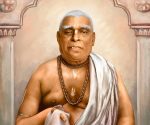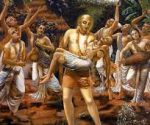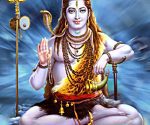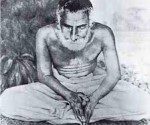Impressions of Bhakti
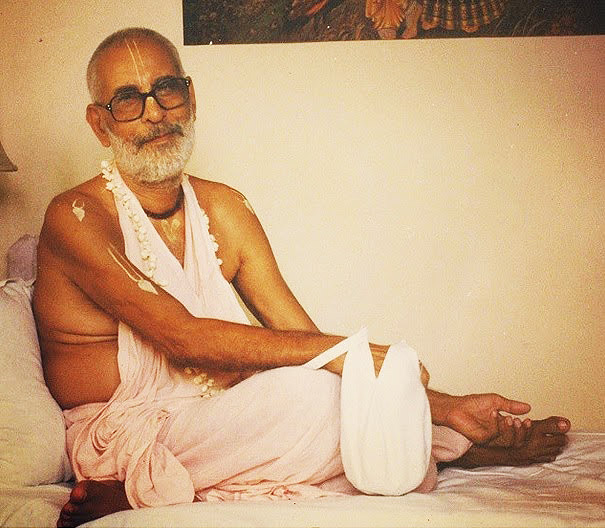 from the booklet comprised of Srimad Bhaktivedanta Narayana Gosvami Maharaja’s dictation (on February 23, 2003 in Olpe, Germany)
from the booklet comprised of Srimad Bhaktivedanta Narayana Gosvami Maharaja’s dictation (on February 23, 2003 in Olpe, Germany)
I was born in 1921 on the amavasya (dark-moon) night in the month of Magha (January). This is what my parents told me. My father’s name was Pandita Balesvarnath Tivari and my mother’s name was Srimati Laksmi-devi. They were both devotees of the Sri sampradaya, initiated according to all rules and regulations, and both were expert in devotional music. My father was also expert in wrestling, singing, and all types of social affairs. He was humble, well-bred, and most importantly, highly religious and conversant with Vaisnava principles.
At the time of my birth, my family’s guru (kula-guru) gave me the name Sriman Narayana Tivari in accordance with the sign of the zodiac. From my birth I was very simple-hearted and innocent. My mother told me, “You would not cry; you would remain seated wherever you were placed. For that reason everyone called you Bholanatha (a name of Lord Siva meaning ‘god of the innocents’).
As my parents were very religious, I was also religious, even from my early childhood. To possess bhakti is not merely a result of practice for one birth, but many births. Throughout my childhood I was always chanting, “Rama, Rama, Rama, Rama, Rama, Rama.” Thus my fortune must have been the result of impressions in my heart (samskaras) due to taking good association and being of religious temperament in my previous births.
As a child I used to attend religious festivals with my father and hear classes on Srimad-Bhagavatam, Ramayana, Mahabharata, and other scriptures. In the evenings, when my father had finished his family duties, he would sometimes personally recite Tulasidasa’s Ramayana to me, and sometimes Mahabharata – from beginning to end.
At that time many village people would also come and listen to him with faith. My impressions were such that even in my childhood I would cry for hours whenever I read the Ramayana of Tulasidasa, and whenever I stopped crying, I would start reading again. I became especially immersed in emotion upon reading about Ramacandra’s exile, His abandoning Sita, and Sita’s entering Patala. I became so immersed that I used to see the battle between Rama and Ravana in my dreams, and I would also see Hanumanji performing his various services. In one dream, at 4 o’clock in the morning, I saw Rama, Laksmana, Sita, and Hanuman descending from an airplane right before my eyes, their divine effulgence radiating everywhere. But then, when I went to touch Their feet, They disappeared. At that time I became so blissful.
Throughout my school years, I ranked first or second in my class in academics. In sports, especially in high school, I won first place awards in the one mile and five mile races, and in the long jump, high jump, cycling races, and boating. No one dared enlist his name for a long race unless he planned to compete for second place, because everyone knew, “Narayana will come first.” I also participated in musical programs and debates in Sanskrit.
Once, when I was sixteen or seventeen, my kula-guru gave a series of classes on Srimad-Bhagavatam in our Tivaripura village. As a great Sanskrit scholar, he would recite every sloka in a melodious voice and then explain its meaning to the crowd of pious listeners that had gathered from the neighboring villages. On those occasions, I had the opportunity to render personal service to him– decorating the lecture hall, preparing his seat, placing the Bhagavatam on his lectern, and then listening to his lectures very attentively. My father also contributed greatly to these programs, by organizing the daily arati of the Bhagavatam and then distributing prasada at the end of each program. The Srimad-Bhagavatam classes were completed after one month, at which time a magnificent yajna was held, followed by a grand feast of the Lord’s maha-prasada. My kula-guru showed me much affection for my services, and he left a great impression on my life.
In this way I became increasingly immersed in the moods of devotion and gradually acquired a taste for krsnabhakti. The Mahaviri Jhanda Festival (in honor of Hanumanji) once took place on the banks of Ganga near my Village, in Ahalyavali – the area where Sri Ramacandraji had liberated Ahalya from Gautama Rsi’s curse, where Visvamitra’s residence was situated, where Rama and Laksmana killed the demoness Tadaka, and where Rama shot His arrows at Marica and Subahu in order to protect Visvamitra’s yajna. It was a great festival, at which many thousands of people gathered.
Various games and wrestling matches were played, which were attended by numerous good sportsmen, and my father also participated as he had versatile talents. It was at this festival that I heard and saw, for the first time in my life, a nagara-sankirtana with thousands of people dancing and singing, “Hare Rama, Hare Rama, Rama Rama Hare Hare, Hare Krsna, Hare Krsna, Krsna Krsna Hare Hare.” That nagara-kirtana had a great impact upon me. When I was in class nine of high school, I received a book that was entitled “The Life-History and Precepts of Nimbarka Vaisnavacarya” as a prize for winning a Sanskrit debate. As I read about the acarya’s perfect Vaisnava demeanor, his deeds, his attachment for harinama, and his rigorous sadhana, I now began to acquire real taste for krsna-nama. It was from this book that I learned that all the Lord’s potencies are present in harinama.
I liked history very much, and I used to get top marks in that subject. In one of the history books I once read a brief description of Sri Caitanya Mahaprabhu. When I saw His picture, with His long wavy hair, and when I read about His absorption in kirtana, I was very deeply impressed and influenced. I was betrothed at the age of sixteen or seventeen, while I was still studying in high school. However, according to Indian custom a wife joins her husband only after the official marriage ceremony, when they are mature. Thus, when I became twenty-one or twenty-two years old, a marriage festival was held for me, and at that time my wife came to live with me. But very soon after that, I left.
(An aside) You can write a little bit regarding the time and place of the marriage, but do not elaborate.
After high-school, because I was good at sports, without any effort I was able to get a position in the police department. The police station was located in the Dumka district of Bihar, at Shahad Ganja, on the banks of the Ganges. All the officers there were happy with me, including the chief superintendent, who was a very religious Bengali. About three years after I began my employment at the police station, the chief superintendent was visited by a party of about ten devotees from Sri Gaudiya Vedanta Samiti in Navadvipa. Among them were prapujya-carana Sri Srimad Narottamananda brahmacariji, Sri Srimad Bhakti-kusala Nrsimha Maharaja, and Sri Radhanatha dasa (who later became pujyapada Bhaktivedanta Trivikrama Maharaja). The speaker, pujyapada Narottamananda brahmacariji, narrated the life history and glorified the character of Sri Prahlada Maharaja in the superintendent’s house for seven days.
Although at that time I did not know Bengali very well, I would sit through the lectures, and in reciprocation with my faith pujyapada Sri Narottamananda brahmacariji became very affectionate towards me. After each lecture, he would leave aside all food and drink to sit with me and speak hari-katha in English throughout the night. [Srila Gurudeva’s servant, Sripad Madhava Maharaja adds, “Pujyapada Narottamananda brahmacari did not know Hindi and Srila Gurudeva did not know Bengali, so they spoke in English.”]
Pujyapada Narottamananda brahmacari was a very learned person, and he was especially a learned scholar in Srimad-Bhagavatam. After listening to his hari-katha for those seven days and receiving his affection, I became completely renounced at heart. I wanted to leave my government position and go with the devotee party, but I could not get permission because of the chief superintendent’s and everyone else’s affection for me. They would not let me go. The superintendent asked me, “Why do you want to go? You will soon be promoted.” I immediately thought of an excuse to leave, and replied, “This is true, but I want to start my own business, so there will be no loss in my going.” When I also told him that in the future I want to do krsna-bhajana, he asked, “Do your parents agree to this?”
I replied, with the understanding that Guruji and the Vaisnavas are my actual parents, “Yes, they do.” I then resigned and left that place, but I did not go home. I went directly from there to Sridhama Navadvipa to meet my Guruji . I arrived at the Navadvipa-dhama railway station at twelve midnight, and wondered, “How will I be able to find the asrama in Navadvipa? I don’t even know the address. Who can I ask at this late hour?” I didn’t know how Guruji knew I would be coming that day, but he knew and Narottamananda brahmacariji also knew; so they had sent Pujyapada Vamana Gosvami Maharaja, lantern in hand and accompanied by another brahmacari to find me. The sight of the two of them approaching made me very happy.
Together with them I arrived at the matha easily, where I saw Narottamananda brahmacariji, my Guruji, and many other Vaisnavas. That day was the eve of the Navadvipa-dhama parikrama. The person in charge of the matha at that time was Sri Narahari Thakuraji, a god-brother of my Guruji and an extremely dear disciple of his Gurudeva Srila Bhaktisiddhanta Sarasvati Prabhupada. Because Sri Narahari Thakuraji took care of everyone in the matha, especially the children, he was affectionately called ‘mother of the matha.’ He would chant harinama throughout the day and night, binding his sikha to a ceiling beam at night so that he would not fall asleep while chanting. Wherever he would go during the day, he continuously chanted harinama.
I was a recipient of his abundant love and affection. Without anyone’s instruction or awareness, I began sweeping the floors in the matha, cleaning the cooking pots, and performing a variety of other services. Shortly after Navadvipa-dhama parikrama was completed, I received both harinama and diksa initiations. Guruji soon became satisfied with my seva and saw my taste for hari-katha, and thus he began to keep me with him and engage me in his personal service. I then started to cook for him and wash his clothes, and I listened to his hari-katha.
That I had previously been a police officer was a distant memory. Everything from the past was left behind. In 1945, just before the beginning of the Kartika parikrama in Vaidyanatha-dhama I went with my Guruji to the Chinchura Gaudiya Matha, where I continued listening to his hari-katha and doing seva. It was there that I met prapuja-carana Srila Bhakti Pramoda Puri Maharaja, and where Guruji engaged me in personal service to him. I began rendering him so many services, such as cooking and giving him water for drinking and bathing. One of my daily services was to accompany him to the nearby Ganga where he would bathe, and I would bring my lota, my last remaining possession from my previous asrama.
One day, while he and I were in the Ganga, the current took my lota. As it floated away I considered, “This is good. Now my last material attachment has gone.” In the following year, I again accompanied Guruji to the Vaidyanatha-dhama parikrama. Later, after the parikrama was completed, Guruji continued to travel and preach. During that preaching tour, Ananga-mohana brahmacari, who was living and travelling with Guruji and who would also sing kirtana for him, fell severely ill with tuberculosis. I was appointed to serve him, at which time I would bring him medicines from a long distance and even clean his body after he passed stool. I took care of him in every respect. One day, as he sat right next to Guruji, he began vomiting blood. I went with Guruji to bring him to a famous homeopathic doctor in Calcutta, and on the doctor’s advice we stayed nearby A holy place famous for Lord Siva’s Jyotir-linga Temple in Deogarh (the abode of the gods), in Jharkand, Bihar. at Siddhavadi. When that and other treatments did not work, Guruji admitted him to a tuberculosis hospital.
Sometime later, I was at a railway station where I met a cousin from our village who was working as a guard there. When he saw me sitting on the train, he boarded it and embraced me. With great happiness he said, “It’s been so long since you left, and you have not sent us a single message. Where are you residing these days?” I told him my address. I was so simple-hearted that I told him. Upon leaving me he immediately sent a telegram to my family, soon after which my mother, father, brother, friends, wife, and many important people of the village – a crowd of ten or fifteen – arrived at the matha. Then, as my mother wept loudly, they all made a concerted effort to convince me to return to them. Although I was ill at that time, I told them, “Don’t worry. I will come with you.” I offered pranama to Guruji and went with them to the village. Upon my arrival, my mother and all other relatives performed puja to Bhagavan in great jubilation, while a band of musicians played on their instruments. Prasada was distributed, and people from all parts of the village – now extremely happy – came to see me.
The next day, my father invited several prominent scholars, as well as the heads of our village and nearby villages, who were wealthy, highly respected, educated, and knowledgeable. He organized a large meeting, attended by a great number of people, including my school friends who came to see me with curiosity. They all tried very hard to convince me to live at home and continue to follow religious principles there. Many of them cited examples from the Mahabharata and the Ramayana. Some said that Prahlada Maharaja was a grhasta and that the Pandavas, also, performed bhajana-sadhana while living as grhasthas. All present made the following recommendation to me: “Perform bhajana at home, as they all did.” “But there is no sadhu-sanga here,” I replied. “And therefore there is no one to instruct me in such a way that my sadhana-bhajana in the path of bhakti can increase. This is unacceptable to me. I cannot live without sadhu-sanga.”
Some others retorted, “Then follow brahmacarya, and at the same time remain at home. Be religious, and at the same time become powerful like your paternal grandfather. Oh, your grandfather was so strong that he would remove bullock carts from the mud. He would untie the bulls and free the carts with his bare hands. When two big buffaloes would fight with the aim of taking each other’s lives, he would take a stick in his hand, strike one buffalo on one side and the other on the other side, and cause them both to run in different directions. Become like your grandfather.”
I replied, “The elephant is also strong. But what is the use of strength without bhakti? I do not want to become strong like that. I want to become strong in bhakti. “Srimad-Bhagavatam (11.9.29) states that without bhakti life is useless: labdhva sudurlabham idam bahu-sambhavante manusyam arthadam anityam apiha dhirah turnam yateta na pated anu mrtyu yavan nihsreyasaya visayah khalu sarvatah syat “’The human form of life is attained only after numerous births of transmigrating through the millions of species. Although this human body is impermanent, it offers the highest benefit. Therefore, until the body lays down and dies another time, if a man is intelligent he will whole-heartedly and immediately endeavor to fulfill his mission of life and achieve his greatest welfare. He must avoid sense gratification, which is available even in the animal species.’
Then, my seventy-five year old paternal uncle, who was the head of one of the other villages, a very important man, and a great scholar, asked me, “All right, then, since you have become a sadhu, can you tell me what is visistadvaita-vada?” I replied that in order to understand visistadvaita-vada, one must first know about kevaladvaita-vada and suddhadvaita-vada (purified dualism); not only that, but one must also know about acintya-bhedabheda-tattva. Then, one by one, I began to define kevaladvaita-vada and all the other theories (vadas). I told my uncle that kevaladvaita-vada, the teaching of Sankaracarya, is the worship of the nirakara, nirvisesa, niranjana, nirguna Brahman, the Absolute Truth devoid of form, speciality, qualities, and designations. According to Sri Ramanujapada’s theory of visistadvaita, the jiva and the material cosmos are specialities of Brahman; although all the energies of the Lord are one, each keeps its individuality (vaisistya). Madhvacarya’s conception is called suddhadvaita-vada and it stresses on the five eternal differences: the difference between jiva (the eternal living entity) and God, between jiva and jiva, between God and matter, between matter and matter, and between matter and jiva.
Then, Sri Caitanya Mahaprabhu’s acintya-bhedabheda-tattva states the one Supreme Personality of Godhead manifests Himself in many, and in this way all diversities are in Him and He is in all diversities although He is nevertheless different from all of them. Thus, by the transformation of His inconceivable potencies, everything is simultaneously one with and different from Him. I explained that all the other philosophies are vadas, meaning theories, but the acintya-bhedabheda philosophy, Sri Caitanya Mahaprabhu’s conception, is a tattva, a truth. It combines the ideas of all the other conceptions, and it is marked by the predominance of pure bhakti. I told my uncle and all those present that acintya-bhedabheda is our conception, the conception of our Guruji. Hearing my explanation, my uncle rose from his seat, embraced me, and said, “You have found a real guru. You have attained sadhu-sanga.
Your renunciation is real and your knowledge of tattva, the established philosophical reality, is complete. From now on, I will not say a word to discourage you.” The meeting ended in this way, and all the people left. That’s enough for today; later I will tell more. There is no need to elaborate on any events other than those about my life in the line of bhakti. Write about me as I have written about my Guruji. You can follow that example, describing my preaching. You can also discuss how, after coming to the matha, I went on so many pilgrimages throughout India. I have written about these in my Guruji’s life history. You only need the dates, the years, the what, and the where. I went to Badrinatha, Dvaraka, and South India two or three times.




